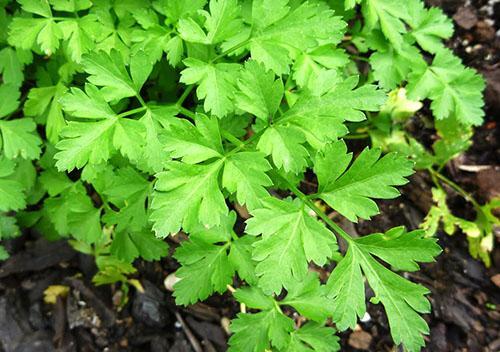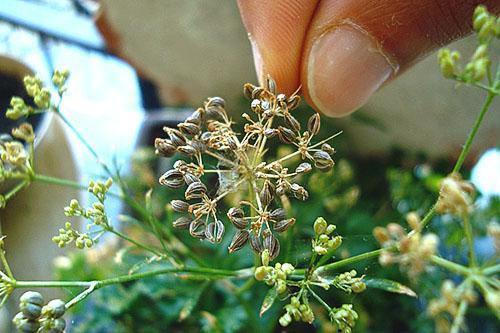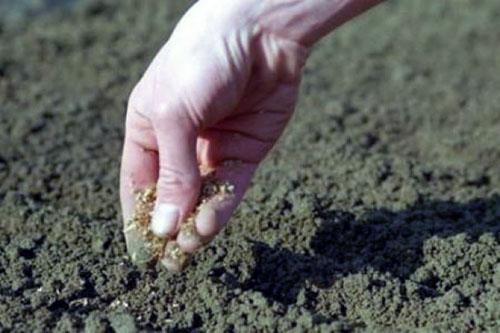Planting and caring for parsley in the open field in the country
 Without parsley, it is difficult to imagine a small gardener's garden and the fields of a modern farm. Parsley, which became a valuable agricultural crop in ancient times, gradually spread from the shores of the Mediterranean Sea to almost all continents.
Without parsley, it is difficult to imagine a small gardener's garden and the fields of a modern farm. Parsley, which became a valuable agricultural crop in ancient times, gradually spread from the shores of the Mediterranean Sea to almost all continents.
In Russia, both leaf and root parsley are planted, and both varieties with the usual leaf shape and with curly ones are grown on greens.
You can distinguish a root crop from a leaf one by a dense, conical, even root crop, like leaves, rich in vitamins, sugars, aromatic substances and microelements. Leaf parsley has thinner and more branched roots. Both types of plants give greens.
Therefore, the cultivation of parsley in the open field is carried out with two goals:
- to obtain root crops and greens, for which a crop is planted with seeds;
- for forcing fresh foliage obtained when planting the roots of the last year.
Planting and caring for parsley outdoors

 If in the spring parsley was planted in open ground with seeds, then the grown plants can be left in the winter. In order for the parsley to have time to prepare for the end of the growing season, it is better to cut the leaves from it no later than September, and with the arrival of cold weather the plants are spud and covered with a layer of mulch from foliage, straw or needles.
If in the spring parsley was planted in open ground with seeds, then the grown plants can be left in the winter. In order for the parsley to have time to prepare for the end of the growing season, it is better to cut the leaves from it no later than September, and with the arrival of cold weather the plants are spud and covered with a layer of mulch from foliage, straw or needles.
With the onset of spring and the melting of the snow, the mulch is removed, and a film shelter is made over the beds. How long to wait for the leaves to appear, and how much does parsley sprout in this case? Fresh parsley will go to the table in April, and the leaves can be cut off until the flower stem rises above the outlet.
If parsley is not left in the soil for the winter, then the roots stored in the basement in early spring:
- shorten to 12-15 cm;
- cleaned of dried and rotten foliage and petioles;
- treated with a stimulant for better root formation;
- planted under a film, leaving a gap of 8-10 cm between the plants.
This will give parsley three early harvests of herbs.
 The main method is to plant parsley seeds in open ground. It is important to take into account that the culture is not fast germinating. Therefore, parsley is often sown with sprouted seeds from early spring to July. In this case, the culture has time to give one harvest and can successfully overwinter.
The main method is to plant parsley seeds in open ground. It is important to take into account that the culture is not fast germinating. Therefore, parsley is often sown with sprouted seeds from early spring to July. In this case, the culture has time to give one harvest and can successfully overwinter.
Root varieties are sown no later than mid-May, so that the parsley has time to form a full-fledged root crop.
Dry seeds fall into the soil before winter. In this case, they are buried in the ground from the second half of October until the very frost, and when the snow cover is established, they are additionally covered with snow. In spring, such crops begin to develop already at 4 ° C, can be grown under film or in the open field, since parsley grown in the open field is not afraid of even frosts down to -9 ° C.
 We can apply to the cultivation of leaf parsley and the seedling method.Sprouted seeds first grow in peat cups or tablets, and in April, at the age of 30–40 days, they are transplanted into open ground. As a result of using this technique, you can get early greens and spend up to six collections per summer season.
We can apply to the cultivation of leaf parsley and the seedling method.Sprouted seeds first grow in peat cups or tablets, and in April, at the age of 30–40 days, they are transplanted into open ground. As a result of using this technique, you can get early greens and spend up to six collections per summer season.
Planting parsley seeds in open ground
 Due to the frost resistance of parsley seeds, this crop is sown starting in early spring. Is it possible to plant parsley in July, will the plant have time to give greens? Until the end of July or the first decade of August, leafy varieties can be sown. If parsley is intended for root crops, then you will hardly have to wait for a good result from the plants sown after mid-May.
Due to the frost resistance of parsley seeds, this crop is sown starting in early spring. Is it possible to plant parsley in July, will the plant have time to give greens? Until the end of July or the first decade of August, leafy varieties can be sown. If parsley is intended for root crops, then you will hardly have to wait for a good result from the plants sown after mid-May.
July sowing of green varieties can produce foliage in the second half of summer, then leave before winter and yield next year.
Without preliminary preparation, parsley seeds hatch extremely slowly. How much does parsley grow? This usually happens no earlier than 2-3 weeks later. Sowing material harvested not earlier than a year ago possesses higher growth energy and germination, but in this case germination can be accelerated:
- Before spring or summer sowing in open ground, the seed is soaked in water with a temperature of 18-22 ° C.
- The water in the seed container is changed every 3-4 hours.
- After 2-3 days, it is left in a solution of a growth stimulator or trace elements for another 18 hours. It is better if oxygen is passed through the liquid at this time, which will speed up the process of pecking the seed.
- Seedlings from the hatched seeds appear within a week.
 When planting parsley in open ground with seeds, about 1 gram of prepared seeds is required per square meter of the ridge. If the culture is sown in the summer, then before planting in the soil, the ridges are watered abundantly, and the number of seeds per square meter is increased by a third.
When planting parsley in open ground with seeds, about 1 gram of prepared seeds is required per square meter of the ridge. If the culture is sown in the summer, then before planting in the soil, the ridges are watered abundantly, and the number of seeds per square meter is increased by a third.
Growing parsley in the open field provides for the preservation of a small interval between individual plants, from 4 to 12 cm, depending on the type and variety:
- Root parsley is sown with an interval of 1–4 cm, while the seeds are lowered into the groove one by one.
- Common parsley is sown at a distance of 10–12 cm, and curly parsley at an interval of 8–10 cm. This crop is sown with 3 or 4 seeds per nest, followed by thinning.
The seeding depth of parsley seeds during spring or summer sowing is 6–10 mm; in autumn, the grooves are made twice as deep.
After planting parsley in open ground with seeds and dusting the furrows, the soil is slightly compacted, carried out watering plantings that are mulched on top or covered with a film.
Outdoor parsley care
 When choosing a site for planting and caring for parsley in the open field, it is better to give preference to the beds where zucchini, pumpkins, cucumbers or tomatoes used to grow. Re-sowing after parsley or other umbellates is carried out after three to four years. For parsley, especially root varieties, loose, cultivated soil rich in organic matter is needed.
When choosing a site for planting and caring for parsley in the open field, it is better to give preference to the beds where zucchini, pumpkins, cucumbers or tomatoes used to grow. Re-sowing after parsley or other umbellates is carried out after three to four years. For parsley, especially root varieties, loose, cultivated soil rich in organic matter is needed.
Excessive soil density leads to deformities of root crops, the seeds germinate worse and slower.
In the fall, when a plot for parsley is being prepared, when digging, 3 to 5 kg of rotted manure or humus are introduced per square meter. After the snow melts, the beds are fertilized in a complex. In this case, there are 4 kg of compost per square meter, 15 grams superphosphate, 10 grams of potassium chloride and 20 grams of nitrate.
 Until the seedlings appear above the surface of the soil, the care and cultivation of parsley consists in careful watering and ventilation of the crops under the film. The emerging weeds are removed, and after germination, not only weeding, but also loosening of the soil, feeding and thinning of seedlings, which is carried out at the stage of 2-3 cut true leaves, is added to the measures for the care of parsley planted in open ground.
Until the seedlings appear above the surface of the soil, the care and cultivation of parsley consists in careful watering and ventilation of the crops under the film. The emerging weeds are removed, and after germination, not only weeding, but also loosening of the soil, feeding and thinning of seedlings, which is carried out at the stage of 2-3 cut true leaves, is added to the measures for the care of parsley planted in open ground.
 Until a full-fledged leaf outlet is formed, parsley is fed twice with infusion of mullein or compost. For 8-10 liters of water, take 1 kg of organic matter, about 15 grams of superphosphate and the same amount of potassium sulfate. In August, plants, especially those grown for root crops, should no longer receive nitrogen-containing fertilizers, so that this element does not accumulate in the roots and aboveground parts of the plant.
Until a full-fledged leaf outlet is formed, parsley is fed twice with infusion of mullein or compost. For 8-10 liters of water, take 1 kg of organic matter, about 15 grams of superphosphate and the same amount of potassium sulfate. In August, plants, especially those grown for root crops, should no longer receive nitrogen-containing fertilizers, so that this element does not accumulate in the roots and aboveground parts of the plant.
Parsley planted in open ground with seeds responds well to foliar feeding with microelements, which are also arranged twice during the growing season.
 Parsley tolerates hot days well, but greens devoid of moisture become noticeably coarser and tougher, but accumulate aromas and essential oils better:
Parsley tolerates hot days well, but greens devoid of moisture become noticeably coarser and tougher, but accumulate aromas and essential oils better:
- If the parsley is to be eaten fresh, the plant needs watering to provide 60–70% soil moisture.
- To get a more flavorful raw material for drying, a couple of weeks before harvesting, parsley is limited to watering.
Cold-resistant parsley can be harvested until late autumn, until frost begins.
At the same time, root crops are removed for storage. Plants that remain overwintered in the ground are carefully spud and mulched.